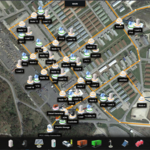The U.S. Department of Defense Taps Xendee to Optimize Microgrid Design for Military Installations

- Xendee’s integrated platform provides a standardized approach that cuts microgrid design time, slashes engineering expenses, and is scalable across the Department of Defense.
- Xendee deployed its microgrid software at three sites: The Naval Submarine Base Kings Bay, The USAG Bavaria, and The Naval Base San Diego.
- The average costs to complete even the most complex modeling using Xendee’s solutions resulted in less than 1 percent of total project costs.
SAN DIEGO–(BUSINESS WIRE)–#asu–Due to the growing threat of blackouts, the U.S. Department of Defense (DoD), through its Environmental Security Technology Certification Program (ESTCP), has enlisted Xendee, a provider of microgrid decision support software, to help significantly cut energy system engineering costs. With the DoD identifying microgrids as a critical technology for increased security, energy efficiency, and resilience at new and existing military installations, the value of microgrids is clear. However, this technology must be optimally planned, designed, deployed, and managed in order to meet organizational goals and mission-critical loads.
As part of this program, Xendee’s software is demonstrated at three different DoD installations. The Naval Submarine Base Kings Bay mandated resilience against outages as a major design priority. Another focus of this installation was examining the ongoing installation upgrades to determine feasibility, return, and alternatives. The USAG Bavaria project, in Grafenwöhr/Vilseck, Germany, included optimized investment, placement, dispatch, financial analysis, power flow engineering, and training for Army staff. This facility also included a full electrical heating system. The Naval Base San Diego was the final demonstration and examined how an onsite microgrid installation could be more cost and emission-efficient than running new cabling to the building.
“Microgrids can reduce military installations’ energy and physical footprint and increase resiliency. They lessen dependence on fuel supplies and their impacts on local communities while improving uninterrupted power. This is all without disruptions to local utility networks,” said Michael Stadler, CTO and co-founder of Xendee. “Through Xendee’s ability to streamline the microgrid design process while cutting costs and increasing efficiency, these three-site demonstrations confirm the value that Xendee’s tool can offer to a military audience.”
Xendee’s platform assessed a number of technologies at these installations, including solar, battery storage, diesel generators, heat pumps, Combined Heat and Power (CHP) engines, and cable and transformer upgrades. Xendee’s optimization engine then analyzed and optimized the investment strategy taken, the sizing and placement of technologies, and the actual dispatch of the system over every time step of the year. This technology streamlined the whole microgrid design and implementation process, saving engineering time and removing the burden and risk of transferring data between systems.
Additionally, as part of this project, Xendee and its partner, Arizona State University, created a DoD-specialized training curriculum designed to train service members on how to use the Xendee software. Xendee also completed DoD Cybersecurity Maturity Model Certification (CMMC), making it a cyber secure platform for DoD applications.
“Our primary objective was to train uniformed and civilian military personnel on a standardized, repeatable process for building and interpreting microgrid models,” said Nathan Johnson, Associate Professor in The Polytechnic School at Arizona State University and Director of the Laboratory for Energy And Power Solutions (LEAPS). “Additionally, by mapping the training program and certificates to military job codes, ASU and Xendee have created a pipeline for training and deploying DoD certified users at scale.” This effort extends a history of training provided by Arizona State University to installation personnel and transitioning Veterans.
Xendee recently announced an integration with UtilityAPI to offer engineers more accurate load data and emission profiles. The integration is meant to aid users in efficiently downloading past building load data directly from utilities, giving engineers more accuracy in past usage and peak project requirements. Xendee also unveiled its new multi-node feature for designing sustainable communities, large facilities, and utility-scale microgrids. Users can connect up to 25 different technologies to generate advanced microgrid designs applicable to real-world positioning.
About Xendee Corporation
Xendee is the new standard in distributed energy system design and operation. The award winning platform integrates the microgrid design process into one piece of software and allows users to rapidly validate projects of any size, optimize designs, optimize investments, and operate microgrids in realtime to reach their full potential. Xendee’s software can model up to 25 different DER technologies and calculates the optimal techno-economic solution for each site individually to meet organizational goals. These goals can include reducing costs, cutting CO2 emissions, increasing resilience, or a combination of all three. Learn more about the clean energy platform or take your first steps towards net-zero carbon and reducing your scope 1 & 2 emissions by setting up a call with us at xendee.com/demo.
Contacts
Media Contact
Jay Gadbois
press@xendee.com

